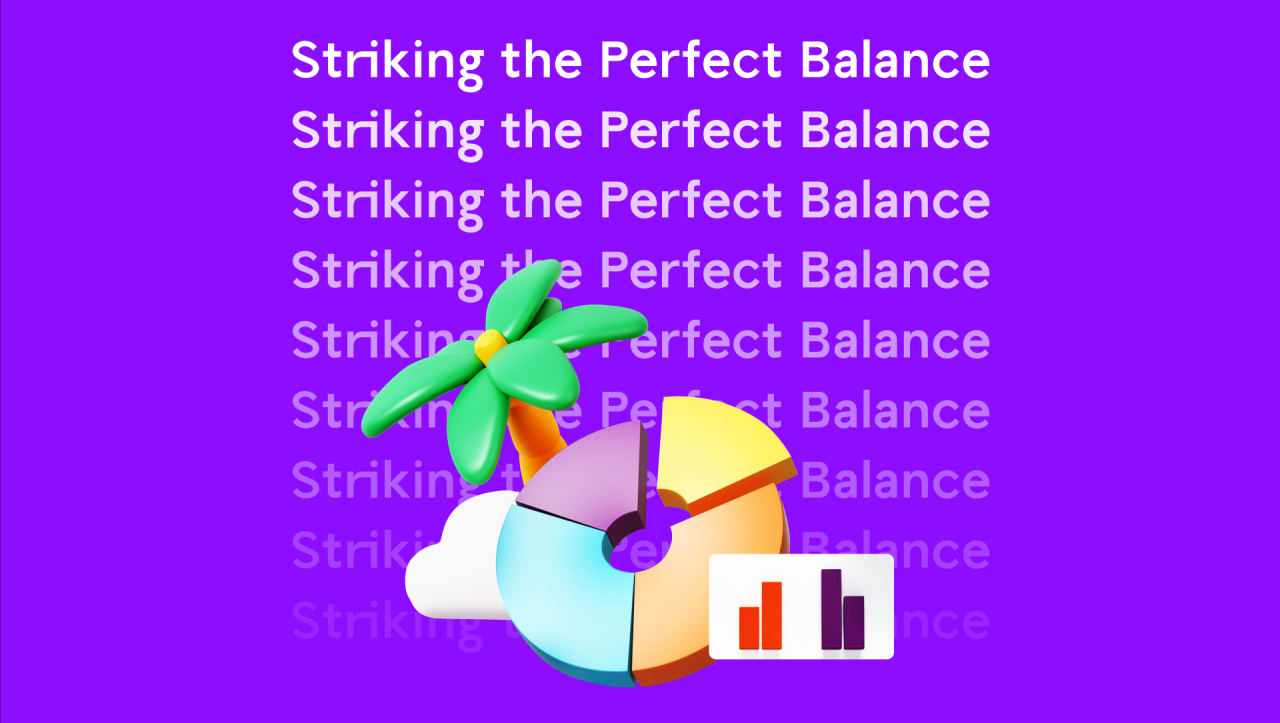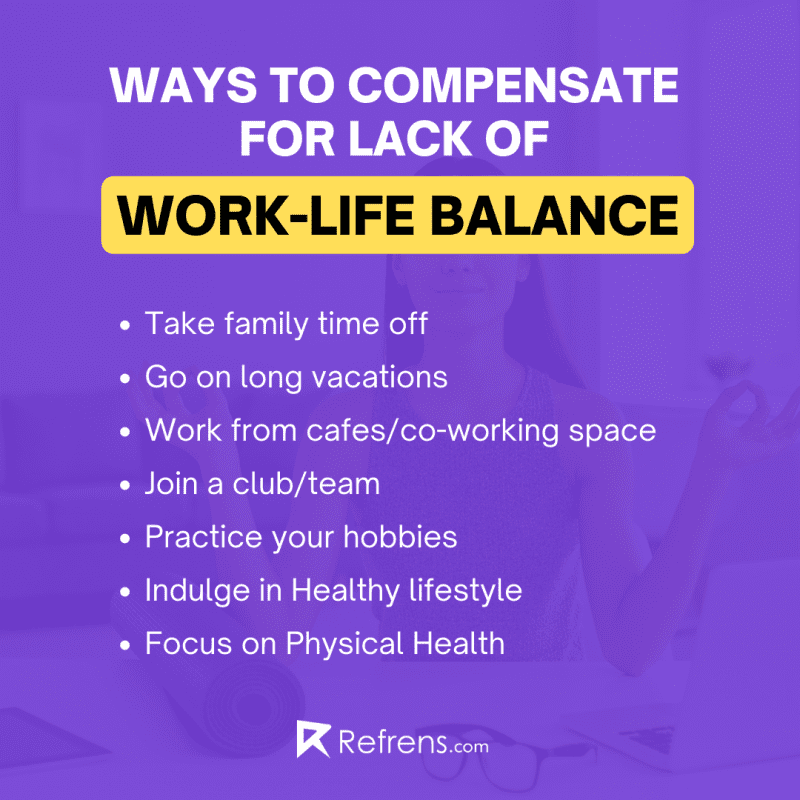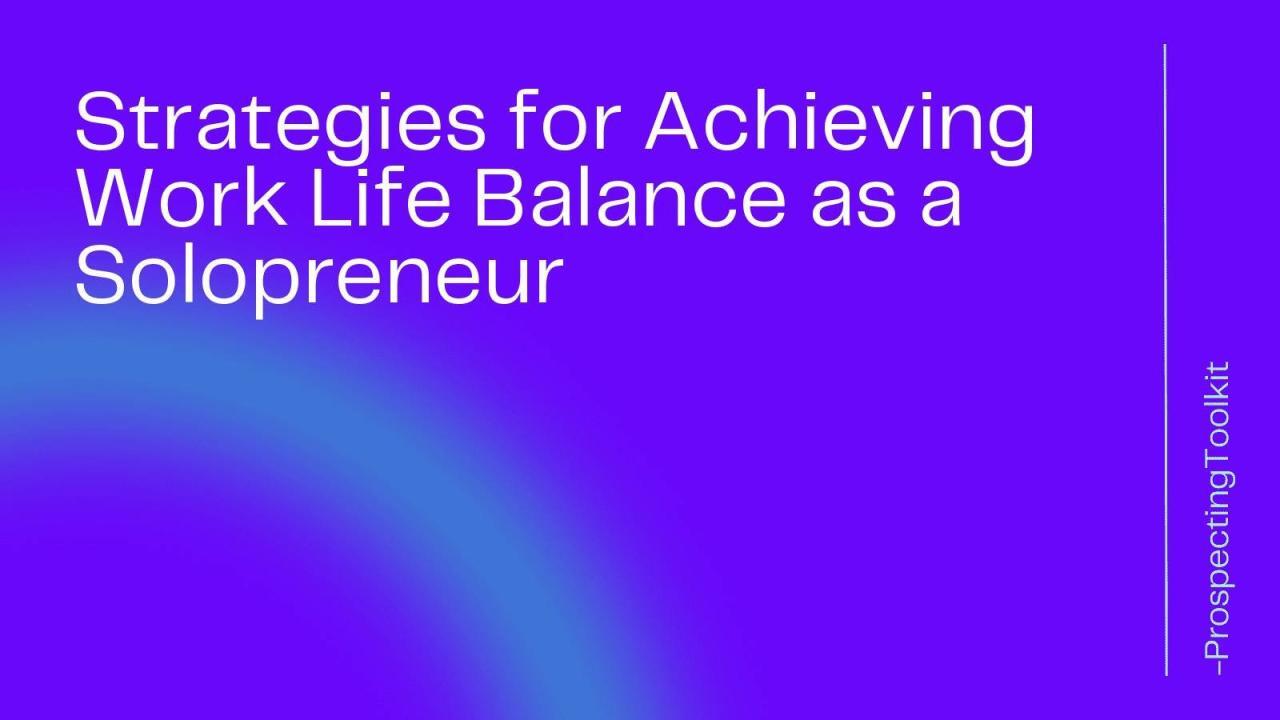Freelancing offers unparalleled flexibility, but maintaining a healthy work-life balance can be challenging. This guide provides a structured approach to navigating the unique demands of freelance work, ensuring personal well-being alongside professional success. We’ll explore defining work-life balance for freelancers, identifying potential barriers, and developing effective strategies for achieving equilibrium.
From understanding the specific challenges freelancers face to practical tools and resources, this comprehensive guide equips you with the knowledge and strategies needed to thrive in your freelance career without sacrificing your personal life. We’ll examine various approaches to defining and measuring balance, providing a framework for assessing your current situation and developing a sustainable plan.
Defining Work-Life Balance for Freelancers

Freelancing offers unparalleled flexibility and autonomy, but it also presents unique challenges in achieving work-life balance. Unlike traditional employees, freelancers often blur the lines between professional and personal spheres. This necessitates a nuanced understanding of work-life balance tailored to the specific demands and opportunities of this lifestyle. This section will delve into defining work-life balance for freelancers, highlighting key differences, and providing a framework for assessment.Achieving a healthy work-life balance as a freelancer requires proactive strategies and a clear understanding of the unique dynamics involved.
Traditional employees typically have structured work hours and defined company policies that contribute to their work-life balance. Freelancers, on the other hand, are often their own managers, responsible for setting their own schedules, boundaries, and work-life integration. This freedom, while empowering, can also lead to burnout and difficulty in separating work from personal life if not carefully managed.
Defining Work-Life Balance for Freelancers
Work-life balance for freelancers is a state of equilibrium where professional responsibilities are effectively managed alongside personal life commitments, resulting in reduced stress, improved well-being, and sustained productivity. It’s not merely about dividing time equally between work and personal life, but about optimizing both spheres to support overall well-being. This necessitates recognizing the unique pressures and opportunities inherent in freelancing.
Key Differences from Traditional Employment
The core difference lies in control and flexibility. Traditional employees often have set schedules and defined work hours, with policies and procedures in place to support work-life balance. Freelancers, however, have complete autonomy in managing their schedules and work-life integration. This flexibility can be a powerful advantage, but it also requires self-discipline and effective time management to avoid burnout and maintain a healthy balance.
Establishing Clear Boundaries
Defining clear boundaries between work and personal time is crucial for freelancers. This involves setting specific work hours, designating a dedicated workspace, and actively disengaging from work during personal time. Examples of boundary-setting include turning off notifications outside of work hours, scheduling specific times for work tasks, and maintaining separate personal and professional communication channels.
Approaches to Defining and Measuring Work-Life Balance
Various approaches exist to defining and measuring work-life balance for freelancers. Some focus on quantitative metrics, such as hours worked per week, or time spent with family. Others emphasize qualitative factors, such as stress levels, job satisfaction, and overall well-being. A comprehensive assessment should consider both quantitative and qualitative elements to provide a holistic view. Different approaches may include:
- Time-based approaches: Tracking time spent on work and personal activities, using tools like time-tracking software. This helps identify potential imbalances and areas needing adjustment.
- Well-being-based approaches: Measuring stress levels, energy levels, and overall satisfaction through self-assessment questionnaires or journaling. This highlights the impact of work on overall well-being.
- Productivity-based approaches: Evaluating the quality and quantity of work output, while considering the time invested. This approach measures the impact of work-life balance on productivity.
Framework for Assessing Current Work-Life Balance
A framework for freelancers to assess their current work-life balance involves several key steps. This framework allows for a comprehensive evaluation and identification of areas needing improvement. A structured approach can significantly aid in creating a more harmonious and productive work environment.
| Category | Questions to Consider |
|---|---|
| Work Time | Are your work hours consistent and well-defined? |
| Personal Time | Are you allocating sufficient time for personal activities and relaxation? |
| Stress Levels | Do you experience stress related to work or personal commitments? |
| Well-being | How satisfied are you with your overall well-being? |
Identifying Potential Barriers to Balance
Maintaining a healthy work-life balance as a freelancer requires proactive identification and management of potential obstacles. This section explores common challenges, focusing on their impact and strategies for mitigating them. Understanding these barriers is crucial for developing effective coping mechanisms and fostering a sustainable freelance career.Many freelancers find themselves struggling to achieve work-life balance due to a multitude of factors.
These factors range from internal issues like poor time management to external pressures like client demands and project deadlines. Recognizing these obstacles is the first step towards creating a more sustainable and fulfilling freelance lifestyle.
Lack of Structure
Freelancers often lack the structured work environment of traditional employment. This absence of predefined schedules and set routines can lead to difficulty in prioritizing tasks and maintaining consistent work hours. Without a clear framework, freelancers may find themselves working excessive hours, blurring the lines between work and personal life. This lack of structure can also lead to procrastination and a sense of overwhelm.
Poor Time Management
Effective time management is essential for freelancers to achieve work-life balance. Poor time management skills can result in missed deadlines, increased stress, and difficulty in setting boundaries between work and personal time. Without proper planning and organization, freelancers may find themselves constantly juggling multiple tasks and feeling overwhelmed by their workload.
Unrealistic Expectations
Many freelancers begin their careers with unrealistic expectations about the pace and nature of work. This can lead to burnout, especially if they underestimate the time required for tasks, underestimate the administrative burdens associated with freelancing, or fail to adequately account for unexpected delays. Learning to manage expectations and setting realistic goals are key to long-term success.
Distractions
Distractions are a significant barrier to freelancer productivity and work-life balance. The home office environment, while offering flexibility, can also be rife with distractions like family members, household chores, social media, and personal errands. These distractions can disrupt focus, leading to longer work hours and a blurring of work-life boundaries. Implementing strategies to minimize distractions is essential for maintaining productivity.
Technology’s Dual Role
Technology, while offering numerous advantages, can also be a significant source of disruption to work-life balance. Tools like email and instant messaging facilitate constant connectivity, leading to an expectation of immediate responses and extended working hours. However, technology can also support balance by providing tools for time management, task organization, and communication with clients.
External Factors
External factors such as client demands, project deadlines, and unexpected events can significantly impact a freelancer’s work-life balance. Unforeseen circumstances like illness, family emergencies, or unexpected project delays can disrupt carefully planned schedules and lead to increased stress. Developing contingency plans and effective communication strategies with clients are essential for navigating these external pressures.
Mental Health Implications
Poor work-life balance can have significant mental health implications for freelancers. Chronic stress, burnout, and anxiety are common consequences of consistently blurred work-life boundaries. This can negatively affect both physical and mental well-being, leading to decreased productivity, reduced quality of life, and potential health problems. Prioritizing self-care and establishing clear boundaries are crucial for freelancers to maintain their well-being.
Strategies for Maintaining Balance

Maintaining a healthy work-life balance as a freelancer is crucial for sustained productivity and well-being. It requires proactive strategies and a flexible approach, adapting to the unique demands of independent work. This section explores practical techniques for freelancers to manage their time, prioritize tasks, and incorporate personal well-being into their schedules.Effective time management is paramount for freelancers to avoid burnout and maintain a fulfilling life outside of work.
A well-structured schedule, incorporating both work and personal time, allows for a more balanced and sustainable routine.
Time Management Techniques
Consistent time management is key to preventing work from encroaching on personal time and vice-versa. By implementing structured routines and utilizing various time management techniques, freelancers can significantly improve their work-life balance. This includes setting clear daily and weekly goals, breaking down large tasks into smaller, more manageable components, and prioritizing tasks based on their importance and urgency.
- Time Blocking: Allocate specific blocks of time for particular tasks or activities. This could include dedicated work hours, breaks, exercise time, or personal appointments. For example, a freelancer might schedule 9 am to 12 pm for client communication and 1 pm to 2 pm for project research.
- The Pomodoro Technique: This technique involves working in focused bursts (e.g., 25 minutes) followed by short breaks. This method helps maintain concentration and prevents burnout by incorporating regular rest periods. Consistency in applying the Pomodoro technique is key to achieving optimal results.
- Prioritization Matrix: Use a prioritization matrix to categorize tasks based on urgency and importance. This aids in focusing on high-priority tasks first, preventing procrastination and ensuring that critical work is completed efficiently.
Creating a Realistic Work Schedule
A realistic work schedule accounts for personal commitments, downtime, and the ebb and flow of freelance work. This includes incorporating regular breaks, mealtimes, and time for personal activities. A well-designed schedule ensures that personal needs are not neglected, preventing burnout and ensuring sustained productivity.
- Flexibility is Key: Freelancers should build flexibility into their schedules. This means allowing for unexpected delays or interruptions, and adjusting work hours based on personal commitments and project demands. For instance, a freelancer might schedule a longer work session on a day with fewer appointments.
- Account for Downtime: Incorporating regular downtime in the schedule is essential for preventing burnout. This could include breaks, relaxation time, or dedicated time for hobbies. Scheduling these activities in advance helps maintain a healthy work-life balance.
- Realistic Task Estimation: Accurately estimating the time needed for tasks is crucial for scheduling. Underestimating project timelines often leads to pressure and a negative impact on work-life balance.
Prioritizing Tasks and Projects
Effective prioritization of tasks and projects is essential for avoiding burnout and maintaining balance. This involves understanding the importance and urgency of tasks and focusing on high-priority items first.
- Eisenhower Matrix: This matrix categorizes tasks based on urgency and importance (urgent/important, important/not urgent, urgent/not important, not urgent/not important). This method helps prioritize tasks based on their impact and deadline, improving efficiency and preventing overwhelm.
- Task Breakdown: Large projects should be broken down into smaller, more manageable tasks. This approach makes the project less daunting and easier to prioritize.
- Delegation (if applicable): Where appropriate, delegate tasks to others to reduce workload and allow time for other responsibilities. For instance, if a freelance writer is overloaded, they may delegate editing or proofreading to a freelance editor.
Setting Boundaries with Clients and Managing Expectations
Clear communication and defined boundaries are essential for managing client expectations and maintaining a healthy work-life balance. This involves establishing clear communication channels, setting reasonable deadlines, and managing expectations around availability and response times.
- Communication Protocols: Establish clear communication protocols with clients, including response times, preferred communication channels, and the availability for different tasks.
- Realistic Deadlines: Collaborate with clients to set realistic deadlines that allow for adequate time to complete projects without compromising personal commitments.
- Saying No: It’s important to learn to say no to clients when projects or demands exceed capacity or conflict with personal commitments. This is crucial for maintaining a healthy work-life balance.
Incorporating Leisure Activities and Self-Care
Leisure activities and self-care are vital components of maintaining a balanced life as a freelancer. This includes dedicating time for hobbies, exercise, social interactions, and other activities that contribute to overall well-being.
- Dedicated Time for Hobbies: Schedule time for leisure activities, hobbies, and interests that bring joy and relaxation. This could include reading, exercising, spending time with loved ones, or pursuing creative endeavors.
- Regular Exercise: Regular physical activity is crucial for mental and physical well-being. This could involve anything from a daily walk to a more intense workout routine.
- Mindfulness and Relaxation Techniques: Incorporate mindfulness practices, meditation, or relaxation techniques into the daily schedule to reduce stress and improve mental clarity. These techniques can contribute significantly to a healthier work-life balance.
Tools and Resources for Freelancers

Maintaining a healthy work-life balance as a freelancer requires strategic planning and the utilization of effective tools and resources. This section will explore various options available to assist freelancers in managing their time, projects, and communication, ultimately fostering a more sustainable and fulfilling work experience.
Project Management Software
Project management software is crucial for freelancers to organize tasks, set deadlines, and track progress effectively. These platforms enable efficient workflow management, reducing stress and improving productivity. Tools like Asana, Trello, and Monday.com offer features for task assignment, collaboration, and progress tracking, allowing freelancers to stay on top of their projects and meet deadlines. Choosing the right platform depends on individual needs and preferences.
Time Tracking Apps
Time tracking apps are essential for freelancers to monitor their work hours and accurately bill clients. This detailed record of time spent on projects enables freelancers to invoice correctly and maintain a clear understanding of their productivity. Tools like Toggl Track, Clockify, and Harvest offer features for time logging, project association, and generating reports. These tools provide valuable insights into workflow patterns, helping freelancers identify areas for improvement.
Communication Platforms
Effective communication is key for freelancers to maintain strong client relationships and collaborate with colleagues. Platforms like Slack, Discord, and Microsoft Teams provide streamlined communication channels for project updates, client interactions, and team collaboration. Using these tools allows for seamless communication, minimizing miscommunication and ensuring everyone is on the same page. These platforms also contribute to a more organized workflow.
Online Communities and Support Groups
Connecting with other freelancers through online communities and support groups provides a valuable network for sharing experiences, advice, and support. These communities offer a platform for freelancers to connect with peers, discuss challenges, and gain insights into different approaches to work-life balance. Websites like Upwork, Fiverr, and freelance forums are valuable resources for connecting with fellow freelancers.
Time Management App Examples
| App Name | Functionality |
|---|---|
| Toggl Track | Time tracking, project association, detailed reporting, integration with other tools |
| Asana | Task management, project organization, collaboration features, deadline management |
| Trello | Visual task management, Kanban boards, collaboration tools, progress tracking |
| Clockify | Time tracking, time sheet generation, project management features, detailed reporting |
Building a Support Network
Building a support network is essential for freelancers. This network can consist of fellow freelancers, mentors, or trusted individuals who offer guidance and encouragement. Participating in online communities, joining local meetups, and connecting with mentors through professional networking platforms can help establish these relationships.
Learning and Development Resources
Numerous online resources offer valuable learning and development opportunities related to time management and work-life balance. Websites like Coursera, Udemy, and Skillshare provide courses and workshops on topics such as productivity techniques, stress management, and goal setting. These resources can provide valuable insights and practical strategies to enhance freelancers’ ability to maintain a healthy work-life balance. Learning from others’ experiences and strategies through online courses is a valuable way to improve one’s approach.
Case Studies of Successful Freelancers

Maintaining a healthy work-life balance is crucial for freelancers to thrive both professionally and personally. This section delves into real-world examples of successful freelancers who have effectively integrated their professional and personal lives. Their experiences offer valuable insights and practical strategies for achieving a similar equilibrium.Successful freelancers often possess a deep understanding of their own needs and limitations, which allows them to tailor their approaches to work-life balance.
Their strategies often involve a blend of time management, organizational skills, and a commitment to setting boundaries between work and personal time. These case studies demonstrate the diverse paths to success and the importance of finding a balance that works for each individual.
Examples of Successful Freelancers
Several freelancers have demonstrated the ability to juggle demanding projects with personal commitments. Their approaches vary significantly, reflecting the unique nature of freelance work and personal preferences.
- Sarah Chen, a graphic designer, prioritizes scheduled breaks and dedicated personal time. She maintains a strict daily schedule that incorporates exercise, social activities, and relaxation. This structured approach allows her to focus on her work when needed, without compromising her personal well-being. She also uses project management tools to ensure deadlines are met efficiently.
- David Lee, a web developer, emphasizes clear communication with clients. He utilizes project management software to clearly define tasks, deadlines, and expectations. This proactive approach allows him to avoid unexpected issues and manage his time effectively. He also sets specific work hours and strictly adheres to them, preventing work from encroaching on his personal time.
- Maria Rodriguez, a writer, values flexible scheduling. She works from home, allowing her to adjust her schedule based on her personal needs and project requirements. This flexibility enables her to attend to personal appointments or family events without impacting her work commitments. She utilizes time blocking to allocate specific time slots for different tasks, both work and personal.
Comparison of Approaches
Different freelancers utilize various strategies to achieve a balanced lifestyle. A comparative analysis of these strategies can reveal common themes and individual preferences.
| Freelancer | Primary Approach | Supporting Strategies |
|---|---|---|
| Sarah Chen | Structured Scheduling | Strict adherence to schedule, scheduled breaks, project management tools |
| David Lee | Clear Communication and Project Management | Defined tasks, deadlines, expectations, proactive issue management |
| Maria Rodriguez | Flexible Scheduling | Work-from-home arrangement, time blocking, adaptability |
Lessons Learned
The case studies highlight several crucial lessons for freelancers seeking to achieve a healthy work-life balance:
- Clear Communication: Effective communication with clients and colleagues is essential for managing expectations and avoiding unnecessary stress.
- Time Management: Utilizing time management techniques, such as time blocking or task prioritization, can greatly improve productivity and reduce the likelihood of burnout.
- Boundary Setting: Establishing clear boundaries between work and personal time is critical for preventing work from overwhelming personal life.
- Self-Care: Prioritizing personal well-being, including exercise, social interaction, and relaxation, is essential for long-term success.
Importance of Balance
Maintaining a healthy work-life balance is paramount for freelancers. It leads to improved mental and physical health, increased productivity, and enhanced job satisfaction. Freelancers who prioritize balance are better equipped to handle the challenges of independent work and experience greater fulfillment in both their professional and personal lives.
Building a Sustainable Work-Life Balance

Establishing a sustainable work-life balance as a freelancer requires conscious effort and consistent adjustments. It’s not a one-time fix, but a continuous process of adapting your approach to work and personal life. This involves recognizing your needs, setting boundaries, and proactively managing your time and energy. A well-structured routine and a flexible mindset are key components of achieving and maintaining this balance.Successfully navigating the complexities of freelance work hinges on understanding the dynamics of work-life integration and developing strategies to prevent burnout.
Freelancers need to proactively identify potential pitfalls and develop coping mechanisms. This includes embracing flexibility, acknowledging personal needs, and recognizing the importance of self-care.
Creating a Step-by-Step Guide
A structured approach to building a sustainable work-life balance is crucial for freelancers. A step-by-step guide offers a practical framework to navigate the complexities of independent work and personal life.
- Define Your Ideal Balance: Clearly identify your personal definition of a balanced work-life structure. Consider factors such as desired work hours, time for personal activities, and the importance of social connections. This involves self-reflection and honest assessment of needs and preferences.
- Establish Clear Boundaries: Define clear boundaries between work and personal time. Designate specific work hours and stick to them as much as possible. Communicate these boundaries to clients and collaborators to avoid overcommitment. This promotes efficiency and avoids blurring the lines between work and personal life.
- Prioritize Tasks and Time Management: Employ effective time management techniques to prioritize tasks and allocate sufficient time for each activity. Use tools like project management software or calendars to schedule tasks and personal appointments. Prioritization minimizes stress and maximizes productivity.
- Integrate Self-Care Practices: Incorporate regular self-care activities into your routine. This could include exercise, meditation, hobbies, spending time with loved ones, or engaging in activities that promote relaxation and well-being. These activities recharge and prevent burnout.
- Regularly Evaluate and Adjust: Continuously evaluate your work-life balance and make necessary adjustments as needed. This is a dynamic process, and flexibility is essential to adapt to changing circumstances and personal needs. Regular evaluation helps ensure the balance remains sustainable.
Avoiding Common Pitfalls
Recognizing and avoiding common pitfalls is essential for maintaining a healthy work-life balance.
- Overcommitment: Taking on too many projects or commitments without sufficient time to complete them can lead to burnout. Prioritize and manage your workload effectively to prevent overcommitment.
- Ignoring Personal Needs: Neglecting personal needs, such as exercise, social interaction, and hobbies, can lead to stress and burnout. Prioritizing self-care is crucial to maintain a sustainable work-life balance.
- Lack of Communication: Poor communication with clients or collaborators can lead to misunderstandings and increased stress. Clear and concise communication is vital for smooth project management and maintaining a healthy work-life balance.
- Procrastination: Procrastination can lead to increased stress and pressure. Developing effective time management strategies is crucial for preventing procrastination.
Importance of Flexibility and Adaptability
Flexibility and adaptability are critical for freelancers to maintain a sustainable work-life balance.
- Adapting to Changing Circumstances: Freelance work often involves unexpected changes in projects or deadlines. Adaptability is crucial to adjust to these changes without compromising personal well-being.
- Balancing Workload and Personal Life: Finding the right balance between work and personal responsibilities requires constant adaptation. Freelancers need to be flexible in adjusting their schedule to meet both demands.
- Embracing Remote Work Opportunities: Remote work often allows for greater flexibility in scheduling and work location. Freelancers should leverage these opportunities to optimize their work-life balance.
Identifying and Addressing Burnout Risks
Burnout is a significant risk for freelancers, and proactive measures are necessary to prevent it.
- Recognizing Symptoms: Recognize the early signs of burnout, such as exhaustion, cynicism, and reduced professional efficacy. Early detection allows for timely intervention.
- Implementing Stress Management Techniques: Implement stress management techniques to cope with work pressures and maintain well-being. Techniques include mindfulness, exercise, and relaxation methods.
- Seeking Support When Needed: Don’t hesitate to seek support from mentors, peers, or therapists when facing burnout. Seeking support helps in navigating challenging situations.
Adapting Work Styles
Freelancers can adapt their work styles to fit their personal needs and preferences.
- Tailoring Work Hours: Adjusting work hours to accommodate personal commitments and preferences is crucial for maintaining balance.
- Creating a Dedicated Workspace: Designating a dedicated workspace, even if it’s a specific corner of a room, can improve focus and productivity.
- Choosing Tools and Technologies: Leveraging the right tools and technologies can streamline workflow and optimize time management.
Final Summary
In conclusion, achieving work-life balance as a freelancer is a journey, not a destination. This guide has provided a roadmap, equipping you with the knowledge, strategies, and resources to navigate the complexities of freelance life. By understanding your specific needs, implementing effective time management techniques, and prioritizing self-care, you can build a sustainable and fulfilling freelance career. Remember, a balanced life is key to long-term success.